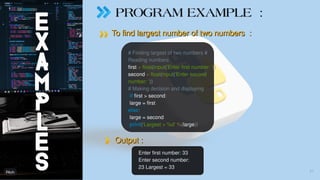Python (3).pdf
- 3. GROUP MEMBERS : MUHAMMAD SAMI ULLAH WARIS (insta: @samiwaris02)
- 4. Table of contents : INTRODUCTION HISTORY USES OF PYTHON FEATURES OF PYTHON PYTHON PROJECT FOR BEGINNERS PYTHON PROGRAM KEY CHANGES IN PYTHON BASIC SYNTAX VARIABLE NUMBERS STANDARD TYPE HIERARCHY STRING CONDITIONALS FOR LOOP FUNCTION KEYWORDS WHY PYTHON ? DIFFERENTIATE EXAMPLES
- 5. • Python is an open-source (free) programming language that is used in web programming, data science, artificial intelligence, and many scientific applications. Learning Python allows the programmer to focus on solving problems, rather than focusing on syntax. • Python is a computer programming language often used to build websites and software, automate tasks, and conduct data analysis. Python is a general-purpose language, meaning it can be used to create a variety of different programs and isn't specialized for any specific problems.
- 6. 1. 2. 3. 4. 5. 6. PARADIGM : DESIGNED BY : DEVELOPER : FIRST APPEAR : STABLE RELEASE : PREVIEW RELEASE : 7. TYPING DISCIPLINE : Multi paradigm : object oriented , procedural , functional , structured, reflective Guido Van Rassum Python Software Foundation February 20, 1991 (31 years ago) 3.10.5 June 6, 2022 (21 days ago) 3.11.0b3 June 1, 2022 (26 days ago) Duck, dynamic, strong typing;[5] gradual (since 3.5, but ignored in CPython)[6]
- 7. USES OF PHYTHON : • • • • • • • • • • • AI and machine learning. ... Data analytics. ... Data visualisation. ... Programming applications. ... Web development. ... Game development. ... Language development. ... Finance … SEO … Design …
- 8. FEATURES OF PYTHON FREE EASY TO LEARN READABLE CROSS PLATFORMS OPEN SOURCE MEMORY MANAGEMENT FREE LARGE STANDARD LIBRARY
- 9. Python Project For Beginners : So, if you were wondering what to do with Python and who uses Python, we’ve given plenty of ideas for how it’s used. Below, we’ve outlined some Python project ideas for beginners. These can help you develop your knowledge and challenge your abilities with the programming language: Build a guessing game Design a text-based adventure game Create a simple Python calculator Write a simple, interactive quiz Build an alarm clock Once you’ve mastered the basics of Python, each of these can challenge you and help you hone the skills you’ve already learned.
- 10. Python Program : • Thus, the same .py file can be a program/script, or a module • This feature is often used to provide regression tests for modules • When module is executed as a program, the regression test is executed • When module is imported, test functionality is not executed
- 11. Key Changes In Python: Python 2's print statement has been replaced by the print() function. There is only one integer type left, int. Some methods such as map() and filter() return iterator objects in Python 3 instead of lists in Python 2. In Python 3, a TypeError is raised as warning if we try to compare unorderable types. eg 1<0> None are no longer valid Python 3 provides Unicode (utf-8) strings while Python 2 has ASCII str() types and separate unicode(). A new built-in string formatting method format() replaces the 5 string formatting operator. K E Y C H A N G E S Old : print Hello, world!! New: (Hello, World!")
- 12. Indentation is used in Python to delimit blocks. The number of spaces is variable, but all statements within the same block must be indented the same amount. The header line for compound statements, such as if, while, def, and class should be terminated with a colon (:) The semicolon (;) is optional at the end of statement. Printing to the Screen: Reading Keyboard Input: Comments Single line: Multiple lines: Python files have extension .py print ("Hello, Python!") name = input ("Enter your name") #This is a comment. . . . print("wo are in a comment") print (we are still in a comment") . . . BASIC SYNTAX : B A S I C S Y N T A X
- 13. VARIABLE : . Python is dynamically typed. You do not need to declare variables! The declaration happens automatically when you assign a value to a variable. Variables can change type, simply by assigning them a new value of a different type. Python allows you to assign a single value to several variables simultaneously. You can also assign multiple objects to multiple variables. counter = 100 miles = 85.6 name = ''John'' Z = None # An Integer assignment # A floating point # A String # A null string x = 1 x = ''string value'' a = b = c = 1 a , b , c = 1, 2, ''John'' V A R I A B L E
- 15. THE STANDARD TYPE HIERARCHY
- 16. STRING : name = ' sami topped in class ' name = '' saqib won match '' name = ''''' najam 's birthday '''' S T R I N G
- 17. CONDITIONALS : IF expression ; statement ; Syntax : Syntax : IF expression statement ; else statement ; IF expression statement ; else statement ; else statement ; else statement ; if statement : if else.else..else.... statement : if else... statement :
- 18. CONDITIONALS : if else statement program : if else statement program : .# If the number is positive, we print an appropriate message num = 3 if num > 0: print(num, "is a positive number.") print("This is always printed.") num = -1 if num > 0: print(num, "is a positive number.") print("This is also always printed.") output : output : 3 is a positive number This is always printed This is also always print
- 19. FOR LOOP : Definition : Definition : syntax : syntax : for val in sequence: loop body • The for loop in Python is used to iterate over a sequence (list, tuple, string) or other iterable objects. Iterating over a sequence is called traversal. • Loop continues until we reach the last item in the sequence. The body of for loop is separated from the rest of the code using indentation.
- 20. FOR LOOP : For Loop program : For Loop program : .# Program to find the sum of all numbers stored in a list # List of numbers numbers = [6, 5, 3, 8, 4, 2, 5, 4, 11] # variable to store the sum sum = 0 # iterate over the list for val in numbers: sum = sum+val print("The sum is", sum) output : output : The sum is 48
- 21. FUNCTION : Definition : Definition : syntax : syntax : def function_name(parameters): """docstring""" statement(s) • • • In Python, a function is a group of related statements that performs a specific task. Functions help break our program into smaller and modular chunks. As our program grows larger and larger, functions make it more organized and manageable. Furthermore, it avoids repetition and makes the code reusable
- 22. Characteristics : Characteristics : Example : Example : def greet(name): ""' This function greets to the person passed in as a parameter """ print("Hello, " + name + ". Good morning!") 1. 2. 3. 4. 5. 6. 7. Keyword def that marks the start of the function header. A function name to uniquely identify the function. Function naming follows the same rules of writing identifiers in Python. Parameters (arguments) through which we pass values to a function. They are optional. A colon (:) to mark the end of the function header. Optional documentation string (docstring) to describe what the function does. One or more valid python statements that make up the function body. Statements must have the same indentation level (usually 4 spaces). An optional return statement to return a value from the function.
- 23. KEYWORDS : Python Keywords Rules : Python Keywords Rules : Examples : Examples : False await else import pass None break except in raise True class finally is return and continue for long • • • • • Keywords are the reserved words in Python. We cannot use a keyword as a variable name, function name or any other identifier. They are used to define the syntax and structure of the Python language. In Python, keywords are case sensitive. There are 33 keywords in Python 3.7. This number can vary slightly over the course of time. All the keywords except True, False and None are in lowercase and they must be written as they are. The list of all the keywords is given below. 23
- 24. Why python ? Extremely versatile language Website development , data analysis…. Syntax is clear , easy to read & learn . Common language . Full modularity , hierarchical packages . Comprehensive standard library for many tasks . Big community . Simply extendable via C/C++ Fast programming speeds
- 25. PYTHON VS JAVA : Python : Python : • • • • • • • • • • Statically typed Compiled Platform-independent Bigger community More libraries and documentation Larger legacy systems Mainly used for web, mobile, enterprise-level Limited string related functions Learning curve is more complex Usually faster than Python Slower development process requiring more lines of code • • • • • • • • • • • Dynamically typed Interpreted Dependent on a platform Smaller yet fast-growing community Fewer libraries and documentation Fewer legacy problems Mainly used for data science, Al, and ML Lots of string related functions Easier to learn and use • Fast but usually slower than Java Faster development process, involves writing fewer lines of code Java : Java : 25
- 26. PYTHON VS JAVA : Welcome : Welcome : # Declaring variables x, y = 12, 10 isTrue = True greeting = "Welcome!" Hello World : Hello World : public class Main { public static void main(String[] args) { // Declaring variables int x = 12, y = 10; boolean isTrue = true; String greeting = "Welcome!"; } } PYTHON : JAVA : print ( '' Hello World '' ) public class Main { public static void main(String[] args) { // To Hello World system out , print in( '' Hello World" ; } } PYTHON : JAVA : 26
- 27. PROGRAM EXAMPLE : To find largest number of two numbers : To find largest number of two numbers : Output : Output : # Finding largest of two numbers # Reading numbers first = float(input('Enter first number: ')) second = float(input('Enter second number: ')) # Making decision and displaying if first > second: large = first else: large = second print('Largest = %d' %(large)) Enter first number: 33 Enter second number: 23 Largest = 33 27
- 28. PROGRAM EXAMPLE : Multiplication table of numbers : Multiplication table of numbers : Output : Output : # Multiplication table of 1 to 10 for i in range(1,11): print("nnMULTIPLICATION TABLE FOR %dn" %(i)) for j in range(1,11): print("%-5d X %5d = %5d" % (i, j, i*j ) MULTIPLICATION TABLE FOR 8 8 X 1 = 8 8 X 2 = 16 8 X 3 = 24 8 X 4 = 32 8 X 5 = 40 8 X 6 = 48 8 X 7 = 56 8 X 8 = 64 8 X 9 = 72 8 X 10 = 80 28
- 29. PROGRAM EXAMPLE : 1 22 333…. pattern numbers : 1 22 333…. pattern numbers : Output : Output : # 1-22-333-4444 Pattern up to n lines n = int(input("Enter number of rows: ")) for i in range(1,n+1): for j in range(1, i+1): print(i, end="") print() Enter number of rows: 8 1 22 333 4444 55555 666666 7777777 88888888 29

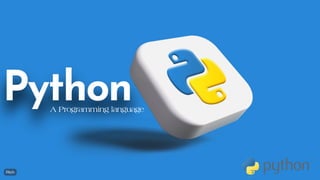



![1.
2.
3.
4.
5.
6.
PARADIGM :
DESIGNED BY :
DEVELOPER :
FIRST APPEAR :
STABLE RELEASE :
PREVIEW RELEASE :
7. TYPING DISCIPLINE :
Multi paradigm : object oriented ,
procedural , functional ,
structured, reflective
Guido Van Rassum
Python Software Foundation
February 20, 1991 (31 years ago)
3.10.5 June 6, 2022 (21 days ago)
3.11.0b3 June 1, 2022 (26 days ago)
Duck, dynamic, strong typing;[5] gradual
(since 3.5, but ignored in CPython)[6]](https://image.slidesharecdn.com/python3-220629220224-5835fc28/85/Python-3-pdf-6-320.jpg)

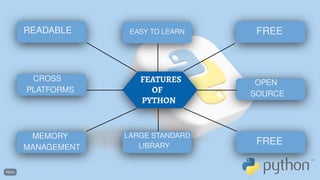

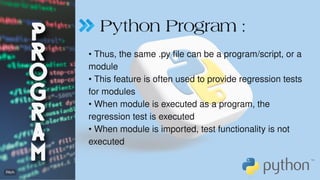


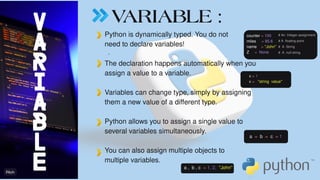
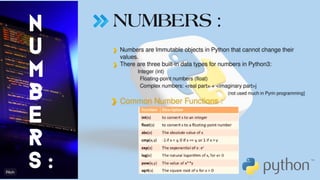


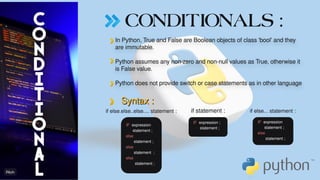


![FOR LOOP :
For Loop program :
For Loop program :
.# Program to find the sum of all numbers stored in a list
# List of numbers
numbers = [6, 5, 3, 8, 4, 2, 5, 4, 11]
# variable to store the sum
sum = 0
# iterate over the list
for val in numbers:
sum = sum+val
print("The sum is", sum)
output :
output :
The sum is 48](https://image.slidesharecdn.com/python3-220629220224-5835fc28/85/Python-3-pdf-20-320.jpg)
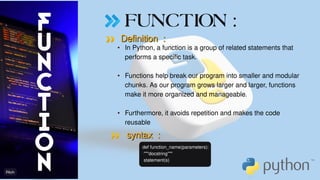




![PYTHON VS JAVA :
Welcome :
Welcome :
# Declaring variables
x, y = 12, 10
isTrue = True
greeting = "Welcome!"
Hello World :
Hello World :
public class Main {
public static void main(String[] args) {
// Declaring variables
int x = 12, y = 10;
boolean isTrue = true;
String greeting = "Welcome!"; } }
PYTHON :
JAVA :
print ( '' Hello World '' )
public class Main {
public static void main(String[] args) {
// To Hello World
system out , print in( '' Hello World" ; } }
PYTHON :
JAVA :
26](https://image.slidesharecdn.com/python3-220629220224-5835fc28/85/Python-3-pdf-26-320.jpg)
